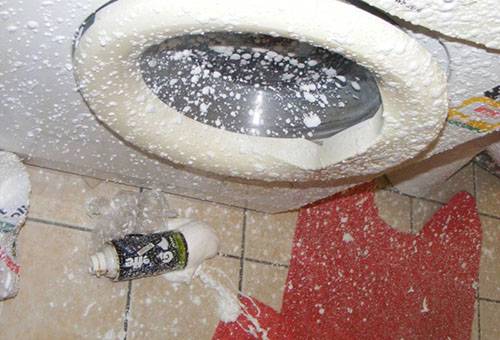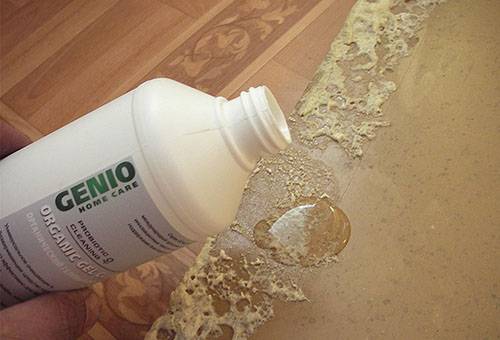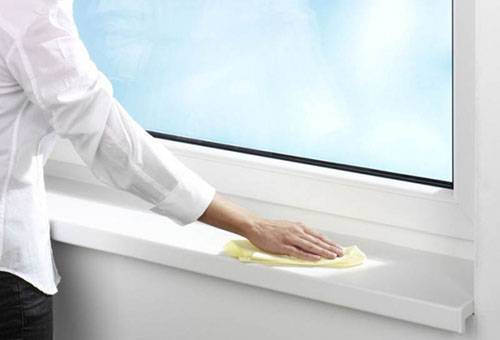How to wipe the mounting foam from various surfaces?
Content:
During the majority of repair, installation or insulation works, high-quality modern sealant - polyurethane foam is actively used. The use of the composition does not cause much trouble, problems arise only when the composition gets to where it is not necessary, because few know how to wash the assembly foam. In some cases, even professionals cannot prevent such a development of events, to say nothing of amateurs who decided to improve the insulation of their windows or doors. Having tried several improvised means against the stains that have formed, they usually leave the composition dry out, thinking that then it can be easily cleaned mechanically. As a result, the work surface, walls or flooring remain forever buried under a layer of foam product.
We remove the remains of polyurethane foam from delicate, glossy and varnished surfaces
The hands of a skilled craftsman must always remain clean, no matter what material he works with. Even if a small accident has occurred, you need to know how to remove this or that material without damaging the skin. Most newcomers try to clean the foam with water, getting the opposite result. Upon contact with tap water, the foam expands and hardens very quickly, which only complicates the situation. Soft cleaners in this case are not helpers, but the use of toxic drugs is very dangerous and extremely undesirable.
- If the pollution is small and does not interfere at all, it is better to leave everything as it is. The product is completely non-toxic and does not harm the skin. After a couple of days, the dried crust can be easily removed or it will fall off on its own, leaving no residue.
- With extensive lesions or, if necessary, the quick elimination of spots, you can turn to a proven folk approach. The problem area is treated with a pumice stone, but before wiping the mounting foam in this way, hands should be held in a solution of medium concentration of salt for several minutes.
Tip
After removing the foam from the surface of the skin, it is recommended to treat the cleaned area with a nourishing or moisturizing cream. This will restore the protective layer and prevent itching or peeling.
It is recommended to remove the composition from the laminate or varnished surface at the stage of formation of the rubber substance. This is when the foam no longer sticks to your hands, but has not yet hardened. You just need to pick up the formation on one edge and carefully remove it from a smooth base. After that, the base can be wiped with napkins impregnated with a cleaner to neutralize greasy traces.
It is almost impossible to wipe the mounting foam from clothing. First we take a very sharp knife and cut the growth almost to the base, trying not to damage the tissue. Next, take some intense solvent and drip onto the stain. We wait 10 minutes and try to scrape off the composition. If it was not possible to remove it, you can decorate the damaged place with an original patch or patch.
Choosing an approach to cleaning a surface covered with varnish, it is worth giving preference to mechanical cleaning: this is more reasonable than subjecting the material to chemical treatment. The product itself is removed using a knife or a sharp spatula. If scratches appear during operation, they can be polished with special tools or repainted.
Affordable and safe fresh foam remover
The easiest way to wash the mounting foam while it is still fresh and has not turned into rubber. First you need to collect the product to the maximum with a scraper, then the turn of the solvent comes. The optimal composition is selected based on the base material.
- The easiest way is to use solvent 646 or regular acetone. But this is not suitable for siding and plastic surfaces.
- Special cleaning solutions for mounting guns allow you to wash the product from any surface.
- Cosmofen. This installer is very fond of window installers. It easily removes foam from plastic and glass. True, given the amount of funds for home use, this is not the most cost-effective option.
- Flushing type "Macroflex". Designed specifically for cleaning doors, floors, walls, windows, clean and already treated surfaces.
Before using any of the listed tools, it is recommended to conduct a test on an inconspicuous area of the material to make sure there are no negative consequences.
Features of cleaning surfaces covered with old spots of polyurethane foam
It is not so easy to wash off the dried yellowed mass. Typically, the procedure has to be repeated more than once to permanently wipe the mounting foam and all its traces. If you just need to cut it off from a metal door with a dangerous battle, and then scrape it off with a hard sponge, then when working with more capricious surfaces one of the following approaches will help.
- Using vegetable oil. First, the foam needs to be removed “under the root”, leaving a very thin film. Wet a soft sponge in vegetable oil (the most common sunflower oil) and apply to areas of foam, impregnating the porous composition. The product should soften after 15-20 minutes. Then with the same sponge, but with the side with a rough nozzle, we try to wash the mounting foam with intensive longitudinal careful movements. After work, a greasy mark will remain on the surface. It is easily reduced with a soapy solution prepared from washing powder or dishwashing detergent.
- With the use of "Dimexidum". Joint gel is purchased at the pharmacy. Work with him is carried out only with gloves, otherwise you can burn the skin. We act in the same way as in the previous method. We cut off all the excess, with a sponge or brush we apply the composition to the remaining film, wait and begin to rub the surface. After processing, you must carefully wash off the traces of the product using first soapy, then clean water.
To remove the mounting foam from a wooden surface without a decorative or functional coating, ordinary sandpaper can be used. We remove the product to the maximum, and wipe off the residues with intensive longitudinal movements on the surface. As soon as possible after that, it is recommended to treat this area with a specialized composition, otherwise the risk of suppuration of the material in this place is high.


